█ █广州梁钜辉治丧委员会特别通知 艺术界第一批捐款名单█ █
汉斯。哈克
Hans Haacke
In an interview with CNN, Haacke said, "This is something that is very grave for all of us if free speech in this city is no longer guaranteed, and the mayor threatens artists and cultural institutions."
在一次CNN电台对哈克其中一个针对纽约市长作品的采访中,哈克说:这对我们大家来说都是很悲哀的,如果这个城市已经失去了它对言论自由的保证,而市长却依然这样威胁着艺术家和文化机构。
Artist Hans Haacke: Museums afraid of me
Whitney heiress says funds will stop
The Art Libel
访谈
访谈
Hans Haacke
In an interview with CNN, Haacke said, "This is something that is very grave for all of us if free speech in this city is no longer guaranteed, and the mayor threatens artists and cultural institutions."
在一次CNN电台对哈克其中一个针对纽约市长作品的采访中,哈克说:这对我们大家来说都是很悲哀的,如果这个城市已经失去了它对言论自由的保证,而市长却依然这样威胁着艺术家和文化机构。
Artist Hans Haacke: Museums afraid of me
Whitney heiress says funds will stop
The Art Libel
访谈
访谈
Another art exhibit riles New York mayor

The 'Sanitation' display makes a political statement

Giuliani says Haacke's work is "an entirely inappropriate way to describe the Holocaust"
March 21, 2000
Web posted at: 10:24 p.m. EST (0324 GMT)
From CNN's Phil Hirschkorn and Deborah Feyerick
NEW YORK (CNN) -- New York Mayor Rudy Giuliani is upset by the world of art again, this time over a display that makes a political statement.
"Sanitation" by German-born artist Hans Haacke (HAHK-uh) was seen for the first time Tuesday as part of a press preview for the Whitney Museum's Biennial 2000 show.
The installation is described as a sharp rebuke of would-be censors of art and free speech. Last year, Giuliani's wrath was provoked by a controversial show, "Sensation," at the Brooklyn Museum. That show, which made a religious statement, featured a painting of the Virgin Mary made in part with elephant dung.
The mayor's remarks and his attempt to cut off funding for the Brooklyn Museum -- an effort that failed in court -- inspired Haacke. The artist is using some of Giuliani's quotes in "Sanitation."
"We will do everything we can to remove funding for the Brooklyn Museum until the director comes to his senses," Giuliani said during last year's controversy.
Here's what "Sanitation" looks like:
In a square, gray room, six anti-art quotes from political figures are posted on a wall, three on each side of mounted American flags.
Three quotes are from Giuliani, with one each from former presidential candidate Pat Buchanan, Christian Coalition founder Pat Robertson and North Carolina Sen. Jesse Helms. The quotes are in the Gothic-style typeface once favored by Hitler's Third Reich.
On the floor is a framed excerpt of the First Amendment of the U.S. Constitution. And standing upright are a dozen garbage cans with speakers emitting military marching sounds.
There are no pictures of Hitler, none of Giuliani and no Nazi symbols or images of the Holocaust.
Giuliani says Haacke's work is "an entirely inappropriate way to describe the Holocaust"
So why is the mayor upset?
"It's an entirely inappropriate way to describe the Holocaust and to try to compare situations to Nazism that have no basis in comparison to it," Giuliani said. "I think it dishonors the memory of the people who lost their lives during the Holocaust."
However, the mayor said he is not personally offended by Haacke's work -- which he has not seen. And because the Whitney is run by private funds, the city government has little leverage regarding it.
However, at least one Whitney heir agrees with Giuliani. Marylou Whitney, a daughter-in-law of museum founder Gertrude Vanderbilt Whitney, has redirected a planned $1 million donation to a different museum in Cody, Wyoming.
But two other Whitney heirs who are active museum trustees -- Flora Miller Biddle, the founding Whitney's granddaughter, and Fiona Donovan, her great-granddaughter -- back the exhibit and Haacke's work.
Art critic Robin Cembalest said of Haacke's work: "I see it as being more political rhetoric than a simplistic parallel between Giuliani and Hitler."
In an interview with CNN, Haacke said, "This is something that is very grave for all of us if free speech in this city is no longer guaranteed, and the mayor threatens artists and cultural institutions."
Haacke said he wants museum visitors "to think about the First Amendment and the threats to the First Amendment we are seeing."
Haacke is one of 97 artists chosen to display work in the biennial Whitney exhibit, which is intended to showcase emerging and established contemporary artists. The exhibition opens to the public Thursday and runs through June 4.
"This will be a show that challenges you. This is part of what art is meant to do," Whitney director Maxwell Anderson told CNN.
Whether it invokes images of the Holocaust or raises issues of free speech, the controversy surrounding the work is bound to boost ticket sales.

The 'Sanitation' display makes a political statement

Giuliani says Haacke's work is "an entirely inappropriate way to describe the Holocaust"
March 21, 2000
Web posted at: 10:24 p.m. EST (0324 GMT)
From CNN's Phil Hirschkorn and Deborah Feyerick
NEW YORK (CNN) -- New York Mayor Rudy Giuliani is upset by the world of art again, this time over a display that makes a political statement.
"Sanitation" by German-born artist Hans Haacke (HAHK-uh) was seen for the first time Tuesday as part of a press preview for the Whitney Museum's Biennial 2000 show.
The installation is described as a sharp rebuke of would-be censors of art and free speech. Last year, Giuliani's wrath was provoked by a controversial show, "Sensation," at the Brooklyn Museum. That show, which made a religious statement, featured a painting of the Virgin Mary made in part with elephant dung.
The mayor's remarks and his attempt to cut off funding for the Brooklyn Museum -- an effort that failed in court -- inspired Haacke. The artist is using some of Giuliani's quotes in "Sanitation."
"We will do everything we can to remove funding for the Brooklyn Museum until the director comes to his senses," Giuliani said during last year's controversy.
Here's what "Sanitation" looks like:
In a square, gray room, six anti-art quotes from political figures are posted on a wall, three on each side of mounted American flags.
Three quotes are from Giuliani, with one each from former presidential candidate Pat Buchanan, Christian Coalition founder Pat Robertson and North Carolina Sen. Jesse Helms. The quotes are in the Gothic-style typeface once favored by Hitler's Third Reich.
On the floor is a framed excerpt of the First Amendment of the U.S. Constitution. And standing upright are a dozen garbage cans with speakers emitting military marching sounds.
There are no pictures of Hitler, none of Giuliani and no Nazi symbols or images of the Holocaust.
Giuliani says Haacke's work is "an entirely inappropriate way to describe the Holocaust"
So why is the mayor upset?
"It's an entirely inappropriate way to describe the Holocaust and to try to compare situations to Nazism that have no basis in comparison to it," Giuliani said. "I think it dishonors the memory of the people who lost their lives during the Holocaust."
However, the mayor said he is not personally offended by Haacke's work -- which he has not seen. And because the Whitney is run by private funds, the city government has little leverage regarding it.
However, at least one Whitney heir agrees with Giuliani. Marylou Whitney, a daughter-in-law of museum founder Gertrude Vanderbilt Whitney, has redirected a planned $1 million donation to a different museum in Cody, Wyoming.
But two other Whitney heirs who are active museum trustees -- Flora Miller Biddle, the founding Whitney's granddaughter, and Fiona Donovan, her great-granddaughter -- back the exhibit and Haacke's work.
Art critic Robin Cembalest said of Haacke's work: "I see it as being more political rhetoric than a simplistic parallel between Giuliani and Hitler."
In an interview with CNN, Haacke said, "This is something that is very grave for all of us if free speech in this city is no longer guaranteed, and the mayor threatens artists and cultural institutions."
Haacke said he wants museum visitors "to think about the First Amendment and the threats to the First Amendment we are seeing."
Haacke is one of 97 artists chosen to display work in the biennial Whitney exhibit, which is intended to showcase emerging and established contemporary artists. The exhibition opens to the public Thursday and runs through June 4.
"This will be a show that challenges you. This is part of what art is meant to do," Whitney director Maxwell Anderson told CNN.
Whether it invokes images of the Holocaust or raises issues of free speech, the controversy surrounding the work is bound to boost ticket sales.

ARTISTS RIGHTS SOCIETY
"Helmsboro County" by Hans Haacke
"Helmsboro Country" by Hans Haacke is part of the new show at the CAC.
(TERRY DUENNES/The Post) .


哈克的艺术可以被归类为观念艺术。在他的作品里我们不难发现他所多数关注的是复杂的社会题材。
自60年代,他开始献身于制作有关艺术,资本和权利之间关系认知的作品。在 Portikus 的展览中他参照了之前备受争议的德国国会大厦项目,国联邦议院在2000年4月份通过了此项目。项目的第一个阶段在其间完成了。哈克在天井中安装了一个21x7米的矮箱,矮箱里呈现了霓虹灯写的---献给民众,这和在大门口上的碑铭(献给德国人民)作为互动。国会联邦议院的成员也同时被邀请在字体的周围填上土囊。在同年九月12日国会联邦议会的会长Wolfgang Thierse将开始此项目的第二阶段,让草皮自然的生长。
Hans Haacke
b. 1936 Cologne, lives in New York
[attachment=95695]
"Shapolsky et al. Manhattan Real Estate Holdings, a Real-Time System, as of May 1, 1971" 1971
142 photographs of New York apartment buildings, 2 maps of New York's Lower East Side and Harlem with properties marked, 6 charts outlining business relations within the real estate group.
Edition of 2. Collection Musee National d'Art Moderne, Centre Georges Pompidou, Paris.
[
这是哈克在纽约古根汉姆美术馆一个声名狼藉的作品,在开幕展前的第六个星期便被查封。展览的策划人Edward Fry当时被解雇而引起了一系列由艺术团体组织的抗议也陆续的在美术馆发生。据推测这件事情的起因是由房地产大亨Shapolsky在美术馆理事的朋友发起的,但是并没有得到任何证明。这个作品叙述了房地产大亨Shapolsky从1951年到1971的黑暗交易。
This is the infamous work that was supposed to be part of Haacke's solo exhibition at the Guggenheim Museum in New York that was abruptly cancelled six weeks before it was due to open. The curator, Edward Fry was fired and a series of protests organized by the art community was staged at the museum. It was speculated that Shapolsky's friends on the Guggenheim's board of trustees were responsible for the cancellation although the allegation was never proved. The piece describes the shady dealings of his real estate firm between 1951 and 1971.
哈克也同时引用了集团赞助人的一些口号制作了一个关于这文献的海报“我们不是赞助人,我们要我们花钱换回来的东西,而且现在就要得到。”“谁出钱,谁控制”
Haacke also executed a new poster project for this Documenta using quotes from corporate sponsors such as "We are not patrons. We want something for the money we spend. And we are getting it." "Whoever pays, controls."
b. 1936 Cologne, lives in New York
[attachment=95695]
"Shapolsky et al. Manhattan Real Estate Holdings, a Real-Time System, as of May 1, 1971" 1971
142 photographs of New York apartment buildings, 2 maps of New York's Lower East Side and Harlem with properties marked, 6 charts outlining business relations within the real estate group.
Edition of 2. Collection Musee National d'Art Moderne, Centre Georges Pompidou, Paris.
[
这是哈克在纽约古根汉姆美术馆一个声名狼藉的作品,在开幕展前的第六个星期便被查封。展览的策划人Edward Fry当时被解雇而引起了一系列由艺术团体组织的抗议也陆续的在美术馆发生。据推测这件事情的起因是由房地产大亨Shapolsky在美术馆理事的朋友发起的,但是并没有得到任何证明。这个作品叙述了房地产大亨Shapolsky从1951年到1971的黑暗交易。
This is the infamous work that was supposed to be part of Haacke's solo exhibition at the Guggenheim Museum in New York that was abruptly cancelled six weeks before it was due to open. The curator, Edward Fry was fired and a series of protests organized by the art community was staged at the museum. It was speculated that Shapolsky's friends on the Guggenheim's board of trustees were responsible for the cancellation although the allegation was never proved. The piece describes the shady dealings of his real estate firm between 1951 and 1971.
哈克也同时引用了集团赞助人的一些口号制作了一个关于这文献的海报“我们不是赞助人,我们要我们花钱换回来的东西,而且现在就要得到。”“谁出钱,谁控制”
Haacke also executed a new poster project for this Documenta using quotes from corporate sponsors such as "We are not patrons. We want something for the money we spend. And we are getting it." "Whoever pays, controls."


Hans Haacke: Grass Grows 1969. Erde, Winterweizen, Roggen, Licht, Wasser. Temporäre
Installation Andrew Dickson White Museum of Art, Ithaca
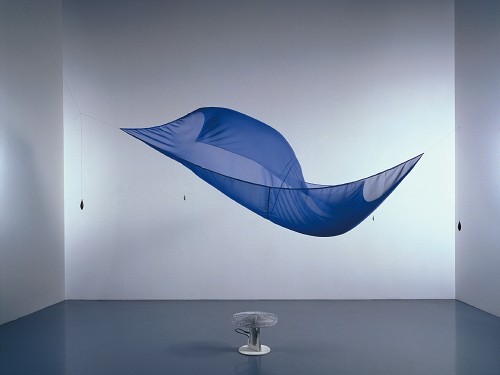
Hans Haacke, Blue Sail, 1964/1965
Hans Haacke's "Blue Sail" (1964-65) comes from a moment now remembered as the cusp of post-minimalism, when various artists first concerned themselves with rooting a work's form in the process of its making or the moment of its perception.
The piece consists of a swath of bright blue fabric, held aloft by four weighted cords and kept in constant fluid motion by currents from an oscillating electric fan on the floor beneath it.
Visitors to the Los Angeles Museum of Contemporary Art's 2004 exhibition "A Minimal Future? Art as Object, 1958-1968" saw "Blue Sail" in a context that underlined Haacke's shift of emphasis from art object to concept. Since the '60s, he has persisted in that direction to the point where people now think of him as a politically motivated conceptual artist who uses objects only as props.
When it was new, the electric fan in Haacke's piece must have looked merely like a tool necessary to effect an idea. At this distance in time, we may connect it more readily to similar fans that appear works by Pop artists such as Claes Oldenburg, Tom Wesselmann and Ed Kienholz, who then seemed to stand across a philosophical divide from people such as Haacke and Robert Morris.
"Blue Sail" adds a key work of time-centered sculpture to SFMOMA's collection of '60s art, one that also anchors the critique of color-field abstraction implicit in some of the museum's other defining works of the period.
哈克的“蓝色帆布”(1964-65)现在被看作后极简主义的尖峰,当时很多艺术家开始关注于作品在制作过程中形式的实质以及对作品片刻间的感知。
作品由一条蓝色的布组成,布的四边由绳子绑紧,下端是一个不断旋转的电子风扇。哈克在这个作品里把艺术品转移至观念。自60年代起他就坚持地往这个方向走,现在人们却认为他是个利用艺术为道具的政治运动观念艺术家。
在那个年代,作品里的电风扇仅仅像个影响观念的道具。事隔那么久,我们现在可以把它联系到很多波普艺术家如Claes Oldenburg, Tom Wesselmann 和 Ed Kienholz 作品里的风扇,和哈克及莫里斯的哲学形成了对立。

Collateral 1991

Untitled

Untitled #1
2005

Untitled #2 2005
Overall: 65 x 19 3/8 x 13 inches (165.1 x 49.2 x 33 cm.)
broomstick: 60" long, 3" diameter (152.4 cm long x 7.6 cm diameter)


Hans Haacke. U.S. Isolation Box Granada, 1983, 1984
An exhibition analysing the political aspects and the element of activism in the artistic practices that have emerged from the second half of the fifties up to the present day. The repertoire of this show questions the aesthetic artefact and posits in its place a utilization of art as an instrument of social observation and critical practice.
The project deploys works and documents with the aim of stimulating debate on the role of the street as a theatre for spontaneous activities, art as service, fiction and the construction of the historical memory, the post-functional object, activism and collaborative working, the questioning of the concept of authorship, alternative models of exhibition and the function of artistic practice in an ideological context.

Condensation Wall
1963-1966
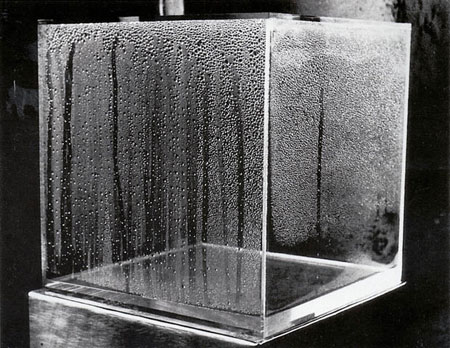

Hans Haacke, "Condensation Cube", 1963
早期的作品,哈克已经在关注体系和过程的问题了。1962年-65年的《凝聚立方体》作品里印证了相关体制对于自身周围环境的依赖,温度的变化致使了水的蒸发和箱子内壁的凝聚。
哈克的《凝聚立方体》是个能够很好理解观念艺术和当代生活的教材。这里,需要考虑的问题包括:应该如何概括和理解这个作品的内容呢?它的内容是什么?我们可以在什么程度上去解释这个作品?这个作品可以被理解为一个贮藏装置吗?如果可以那么它贮藏的又是什么呢?






Hans Haacke's poster project - white posters featuring negative space of the World Trade Center towers' silhouettes - commemorates
September 11th. Starting on the six-month anniversary of the attacks through March 25, 2002, Haacke's posters appeared on scaffolding
and media walls across the City with remnants of previous posters occupying the void of the missing towers. Haacke's project reminds us
that the events of September 11th have created a filter through which we experience and measure our everyday realities.
To extend the gesture to the surface of our computer desktops the project is available online as a downloadable desktop application.
In the desktop version, screen-savers, browsers, files, and applications become the shadows of the World Trade Center towers.
The Haacke project is Creative Time's second poster campaign in response to September 11th. The medium bears particular relevance for
a public art project due to its widespread public visibility and historic implementation by artists.
Hans Haacke is an artist based in New York. For decades, he has produced challenging works that focus on interaction and conflict,
both in nature and in society - how they affect our visual culture, and thereby our sense of the world.
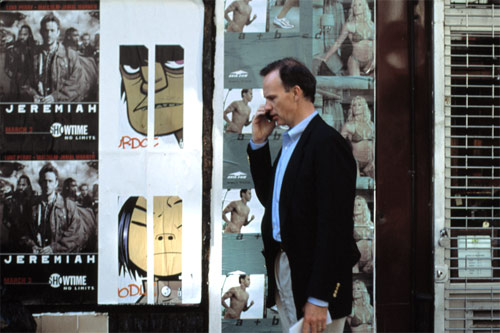
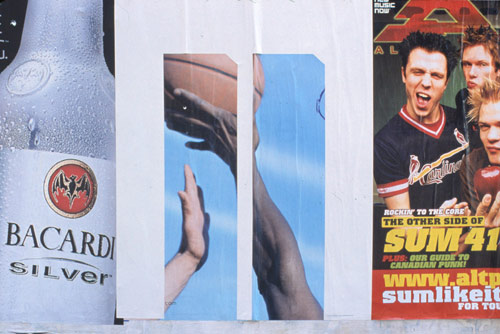
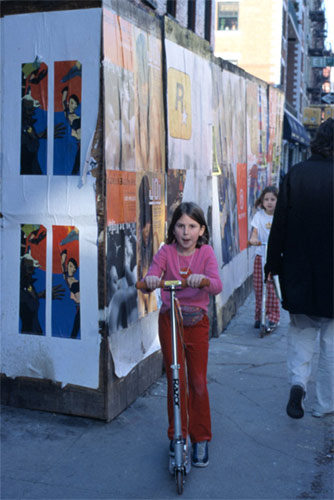
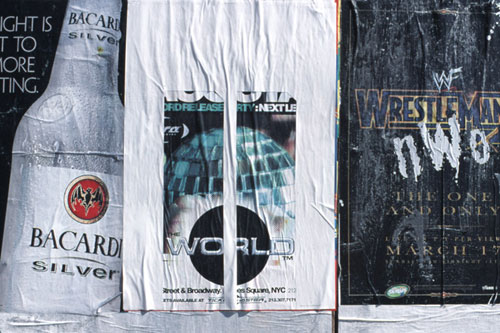
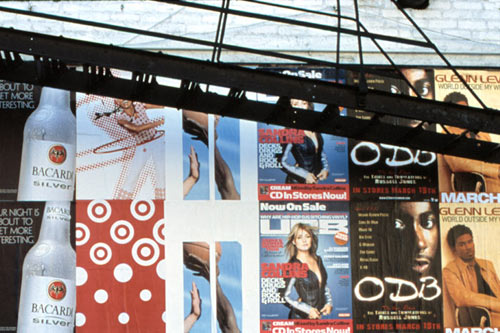
September 11th. Starting on the six-month anniversary of the attacks through March 25, 2002, Haacke's posters appeared on scaffolding
and media walls across the City with remnants of previous posters occupying the void of the missing towers. Haacke's project reminds us
that the events of September 11th have created a filter through which we experience and measure our everyday realities.
To extend the gesture to the surface of our computer desktops the project is available online as a downloadable desktop application.
In the desktop version, screen-savers, browsers, files, and applications become the shadows of the World Trade Center towers.
The Haacke project is Creative Time's second poster campaign in response to September 11th. The medium bears particular relevance for
a public art project due to its widespread public visibility and historic implementation by artists.
Hans Haacke is an artist based in New York. For decades, he has produced challenging works that focus on interaction and conflict,
both in nature and in society - how they affect our visual culture, and thereby our sense of the world.







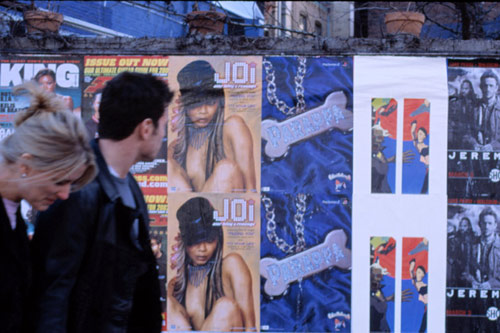
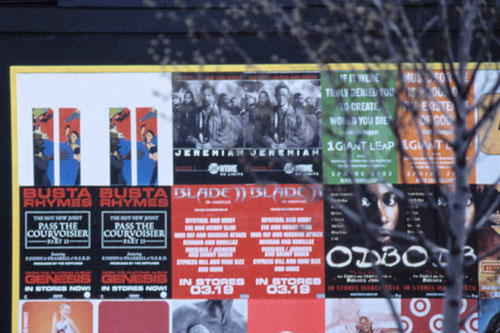


Haacke feels compelled in his work to comment on the history of the museum and the function it plays in contemporary society. His main focus has been on audience interpretation and the context in which objects are displayed. He also focuses on the history of the museum and its relationship to imperialism and how much of the objects in British collections were infact stolen from the countries they invaded and exhibited like trophies.、
哈克在他一个指向博物馆历史及其在当代社会角色的作品中感到激动。他的目标在于观众的解读和展示物品的内容。同时也关注博物馆和帝国主义的历史关系以及英国是如何的把他们很多其实都是在侵略中偷回来的的文物当成战利品一样的呈现在博物馆中。
"For the past fifteen years, Hans Haacke's work has been concerned with issues that are at the core of postmodern investigations - the nature of art as institution, the authorship of the artist, the social behavior of the art world, the network of cultural policies such as the role and function of the museum, the critic, and the public, and many other sociological problems."
在过去的15年中,哈克的作品关注于一些核心的后现代研究--艺术的自然制度,艺术家的身份,艺术世界的社会行为,文化政治的网状关系如美术馆的体系,批评家,大众和其他一些社会问题。
Haacke challenges audiences perceptions as he continually critiques the museum. His installations may seem confusing to viewers who stumble upon them, as he simply uses objects in the museum collection to create an installation. The choice and arrangement of objects in the installation is important as they contain subtle messages.
在批判美术馆的同时哈克也向观众的感知提出挑战。他的装置作品似乎绊着,扰乱着观者,尤其他只是简单的利用了博物馆的文物作为装置。但是这些文物的选择和摆放都是非常重要的因为他们暗示着一些敏感的信息。


Hans Haacke
Germaina
Venice Biennale, 1993
[http%3a//www.kunst.uni-stuttgart.de/seminar/haacke/bilder/innen2.jpg>

Hans Haacke, Germania (1993): responding to the Nazi horror
photo Roman Mensig, ?Hans Haacke/VG Bild-Kunst



一切开始于哈克在惠特尼美术馆的作品--《Sanitation》清理,一个明显为反射布格林美术馆声名狼藉的的《Sensation》展。纽约市长和其党羽利用了其中一个背靠在墙上的垃圾箱,军伐声装置和一排写了:Gothic Fraktur(一个古老的德国口号,希特勒曾用其复苏德国主义精神) 的字体攻击哈克拥有反犹太倾向。
“我非常失望”,艺术家哈克对在市中心的新艺术丑闻事件中说。针对他在惠特尼美术馆里的装置引起的狂热:“我做过无数次关于德国过去的作品,现在我被误为反闪米特人分子,被告为对犹太人不敬而感到悲痛,是的。”



Visitors’ Profile consists of a questionnaire about contemporary events that was distributed to museum visitors to a group exhibition in Milwaukee. While Haacke had used questionnaires in his works before, this particular questionaire was the first time that he successfully used a computer to compile the results and generate a statistical profile of the exhibition’s audience. This important historical work introduces the idea of visitorsplaying an active role in their information environment and “completing” the work of art.



Hans Haacke MOMA Poll (1970)

In 1970, at the Information center of the Museum of Modern Art, Hans Haacke posited this query, a response algorithm, and its visual feedback/evolving result as art:
Would the fact that Governor Rockefeller has not denounced President Nixon's Indochina Policy be a reason for you not voting for him in November?
"Ballots" were dropped into either of two plexi-glass ballot boxes (visitors chose "yes" twice as often as "no").
1970年,哈克在moma的信息中心安置了这个疑问,一个运算程序,是一个直接的视觉反馈/艺术所展开的结果:
你会不会因Rockefeller 没有公开谴责尼克松总统对印度支那的政策而在11月份不投票给他?
“票”将会投进两个塑料玻璃箱里(观众们投的“是”是“不”的一倍)

Hans Haacke, Bowery Seeds (Bowery Samen), 1970 New York City, New York, © VGBild-Kunst
For Bowery Seeds, Haacke carved out a small circular area of earth, enabling airborne seeds to take root.



上黑社会前看来还需要把英语水平锻炼好啊!
[img]http://img.mop.com/images/face/309.gif[/img]
哈哈哈哈
楼上说的对阿! 别烦我忙死了
HAACKE, Hans.
WaveI, 1964
140cmx20cm
WaveI, 1964
140cmx20cm
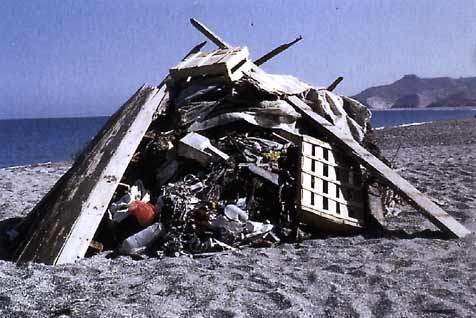
Hans Haacke - Beach Pollution - 1970 - Espagne
Th artistic activities of Hans Haacke (b. 1936, living in New York) can be situated in the context of concept art.
In his works, Hans Haacke is concerned with complex social contexts. Since the '60s, the artist is dedicated, among others things, to creating awareness of the relationships between art, capital, and power. In the exhibition at Portikus, Hans Haacke makes reference to his controversial project for the Berlin Reichstag building; the Bundestag (Lower House of Parliament) consented to its realisation on April 5, 2000. The first phase of the project has meanwhile been completed. In a low box measuring 21 x 7 metres installed on the floor of one of the two light-wells, Haacke's dedication DER BEVÖLKERUNG (TO THE POPULATION) was set in white neon-sign letters to complement the inscription DEM DEUTSCHEN VOLKE (TO THE GERMAN PEOPLE) located above the entrance portal. The members of the Bundestag have been invited to strew soil from their respective constituencies around the letters. On September 12, the President of the Bundestag, Wolfgang Thierse, will initiate this second phase of the project. Spontaneous growth will be left to itself.
The exhibition additionally alludes to the architectural parallels and the significant differences between the pictorial programmes and the inscriptions of the Frankfurt portico and the portico of the Reichstag building. Hans Haacke has thus developed a version of his Berlin project conceived especially for this specific context.
In his works, Hans Haacke is concerned with complex social contexts. Since the '60s, the artist is dedicated, among others things, to creating awareness of the relationships between art, capital, and power. In the exhibition at Portikus, Hans Haacke makes reference to his controversial project for the Berlin Reichstag building; the Bundestag (Lower House of Parliament) consented to its realisation on April 5, 2000. The first phase of the project has meanwhile been completed. In a low box measuring 21 x 7 metres installed on the floor of one of the two light-wells, Haacke's dedication DER BEVÖLKERUNG (TO THE POPULATION) was set in white neon-sign letters to complement the inscription DEM DEUTSCHEN VOLKE (TO THE GERMAN PEOPLE) located above the entrance portal. The members of the Bundestag have been invited to strew soil from their respective constituencies around the letters. On September 12, the President of the Bundestag, Wolfgang Thierse, will initiate this second phase of the project. Spontaneous growth will be left to itself.
The exhibition additionally alludes to the architectural parallels and the significant differences between the pictorial programmes and the inscriptions of the Frankfurt portico and the portico of the Reichstag building. Hans Haacke has thus developed a version of his Berlin project conceived especially for this specific context.
Located on the Munster promenade there is a war memorial Ehrenman am Mauritztori. The sculptor Bernhard Frydag chiseled on his monument the following dedication.," 1864 1870-71 1866 IN MEMORY OF WARS AND VICTORIES AND THE REESTABLISHMENT OF THE REICH". These dates refer to the wars Bismarck waged against neighbors of Prussia. This war is known in the German history books as the German-Danish War which led to the annexation of Schleswig-Holstein by Prussia and ( for two years) Austria. and the German French war. In 1871, in Versailles, the Prussian King Wilheim I was proclaimed emperor of the newly established Reich. Since 1815, Munster has been part of the Prussian province Westphalia. The monument Ehrenmal am Mauritztor is popularly called,"Masentempel" (monument of asses). Haacke has erected right next to this monument , exactly in the diameter and height (6 to 7 meters) cylindrical shack made from rough blanks. Barb wire is placed around the top t prevent the wall from being scaled. A children's carousel with lights and music (Deutschland Uber Alles - the German National Anthem) plays on and on...directly enclosed behind the planks. Only where there are small gaps in the planks can you glimpse the carousel. the inverted juxtaposition between the monument and the enclosed cylindrical wall creates a profound and moving statement.



HANS HAACKE
DEM DEUTSCHEN VOLKE - DER BEVÖLKERUNG
08/26/00 - 10/08/00
Th artistic activities of Hans Haacke (b. 1936, living in New York) can be situated in the context of concept art.
In his works, Hans Haacke is concerned with complex social contexts. Since the '60s, the artist is dedicated, among others things, to creating awareness of the relationships between art, capital, and power. In the exhibition at Portikus, Hans Haacke makes reference to his controversial project for the Berlin Reichstag building; the Bundestag (Lower House of Parliament) consented to its realisation on April 5, 2000. The first phase of the project has meanwhile been completed. In a low box measuring 21 x 7 metres installed on the floor of one of the two light-wells, Haacke's dedication DER BEVÖLKERUNG (TO THE POPULATION) was set in white neon-sign letters to complement the inscription DEM DEUTSCHEN VOLKE (TO THE GERMAN PEOPLE) located above the entrance portal. The members of the Bundestag have been invited to strew soil from their respective constituencies around the letters. On September 12, the President of the Bundestag, Wolfgang Thierse, will initiate this second phase of the project. Spontaneous growth will be left to itself.
The exhibition additionally alludes to the architectural parallels and the significant differences between the pictorial programmes and the inscriptions of the Frankfurt portico and the portico of the Reichstag building. Hans Haacke has thus developed a version of his Berlin project conceived especially for this specific context.
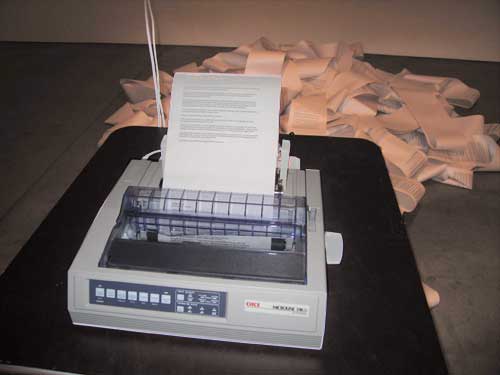
Hans Haacke, news, 1969 / 2005, at the state of the union show, Paula Cooper Gallery

ding!

[s:64]
半岛艺术空间
艺术家汉斯。哈克:美术馆害怕我
玛雅。朵拉亥德
freedomforum.org特稿
“艺术家与私营美术馆之间的战争,没有一场是赢的,但如果没有引起公众的注意,那么自由将枯竭。”德国观念艺术家汉斯。哈克昨晚在第一修正案中心说道。
关于艺术的自由表达的讨论是“惠特尼对话”节目的一个部分,这个节目系列由惠特尼美术馆和第一修正案中心共同主办。“惠特尼对话”为“自由演说”节目录制,这是第一修正案中心的电视节目,由第13频道——“大都市艺术”频道播出。
去年,哈克在惠特尼双年展的作品引起了纽约艺术界的骚乱。一些人把他的作品看作是对德国纳粹对犹太人的大屠杀的轻描淡写和不屑。
主持人肯。保尔森,第一修正案中心的执行理事指出,哈克的展出“激起了市长的反对”并促使了一场新闻媒体的骚乱,虽然这个作品之前已有展出过。
“这令人非常震惊和恐慌,”哈克说,“纽约时报刊在头版重彩描述了我的作品。”他称市长和媒体的指控为“大鱼吃小鱼”。
而采用这件作品的惠特尼美术馆,依然让这个作品按照计划继续展出。
“在惠特尼,我们频繁地在地下采用艺术家和他们的作品。美术馆的执行理事马克思威尔。安德森说。“我不能再资助任何一个我们已经委任的艺术家,我们已经非常尊重惠特尼给它的艺术家的承诺”
但并非所有的美术馆都能这样看待哈克的作品。在70年代,据说由于当地的一个著名商人揭发“罪行”,纽约的古根海姆美术馆取消了一个哈克的作品。
“古根海姆邀请我做个展,但是当他们看见我的作品时,展览取消了”哈克说
一个经常和私营背景的美术馆合作的艺术家,他的表达自由可成为自由言论拥护者的关注,小组辩论者们说道。
但这种对企业的关注逐渐变得更多的是政治上的,他们说——一个显著的例子便是纽约市长鲁道夫。戈尔里阿尼对布鲁克林美术馆的艺术品的勃然大怒。
“今天的企业文化已经变成让更年轻的观众接受的自嘲”,马克斯威尔说道。哈克表示赞同:“企业不会告诉美术馆艺术品是干什么的”。
不管如何,策展人需要缓和那些赞助他们的人的情绪来达到共协。
“美术馆害怕你吗?”保尔森问哈克。
“这些年来,我想是的”他回答道。“在古根海姆的展览取消之后,很多美术馆,用不可理解的理由,把我排除在外。”
哈克坦率直言的信仰也许失去了他的展览机会,但他的作品还幸存。他的展览“说服力”在纽约伦巴地—佛雷德画廊自主进行。另一个名为“忽然着魔”的展览在纽约当代艺术美术馆进行,并属于非永久性的收藏。
玛雅。朵拉亥德
freedomforum.org特稿
“艺术家与私营美术馆之间的战争,没有一场是赢的,但如果没有引起公众的注意,那么自由将枯竭。”德国观念艺术家汉斯。哈克昨晚在第一修正案中心说道。
关于艺术的自由表达的讨论是“惠特尼对话”节目的一个部分,这个节目系列由惠特尼美术馆和第一修正案中心共同主办。“惠特尼对话”为“自由演说”节目录制,这是第一修正案中心的电视节目,由第13频道——“大都市艺术”频道播出。
去年,哈克在惠特尼双年展的作品引起了纽约艺术界的骚乱。一些人把他的作品看作是对德国纳粹对犹太人的大屠杀的轻描淡写和不屑。
主持人肯。保尔森,第一修正案中心的执行理事指出,哈克的展出“激起了市长的反对”并促使了一场新闻媒体的骚乱,虽然这个作品之前已有展出过。
“这令人非常震惊和恐慌,”哈克说,“纽约时报刊在头版重彩描述了我的作品。”他称市长和媒体的指控为“大鱼吃小鱼”。
而采用这件作品的惠特尼美术馆,依然让这个作品按照计划继续展出。
“在惠特尼,我们频繁地在地下采用艺术家和他们的作品。美术馆的执行理事马克思威尔。安德森说。“我不能再资助任何一个我们已经委任的艺术家,我们已经非常尊重惠特尼给它的艺术家的承诺”
但并非所有的美术馆都能这样看待哈克的作品。在70年代,据说由于当地的一个著名商人揭发“罪行”,纽约的古根海姆美术馆取消了一个哈克的作品。
“古根海姆邀请我做个展,但是当他们看见我的作品时,展览取消了”哈克说
一个经常和私营背景的美术馆合作的艺术家,他的表达自由可成为自由言论拥护者的关注,小组辩论者们说道。
但这种对企业的关注逐渐变得更多的是政治上的,他们说——一个显著的例子便是纽约市长鲁道夫。戈尔里阿尼对布鲁克林美术馆的艺术品的勃然大怒。
“今天的企业文化已经变成让更年轻的观众接受的自嘲”,马克斯威尔说道。哈克表示赞同:“企业不会告诉美术馆艺术品是干什么的”。
不管如何,策展人需要缓和那些赞助他们的人的情绪来达到共协。
“美术馆害怕你吗?”保尔森问哈克。
“这些年来,我想是的”他回答道。“在古根海姆的展览取消之后,很多美术馆,用不可理解的理由,把我排除在外。”
哈克坦率直言的信仰也许失去了他的展览机会,但他的作品还幸存。他的展览“说服力”在纽约伦巴地—佛雷德画廊自主进行。另一个名为“忽然着魔”的展览在纽约当代艺术美术馆进行,并属于非永久性的收藏。
访谈原文:Artist Hans Haacke: Museums afraid of me
By Maya Dollarhide
Special to freedomforum.org
NEW YORK — "None of the battles (between artists and private museums) have been won, but if there is not an alert public these [freedoms] will wither," said conceptual German artist Hans Haacke last night at the First Amendment Center.
The discussion of artistic free expression was part of the "Whitney Dialogues" program series co-sponsored by the Whitney Museum and the First Amendment Center. It was taped for "Speaking Freely," a First Amendment Center television show on MetroArts channel 13.
Haacke's exhibit at the Whitney Biennial caused a commotion in the New York art world last year. Some characterized his work as downplaying and trivializing the.
Co-moderator Ken Paulson, First Amendment executive director, noted Haacke's exhibit "roused the mayor's objections" and prompted a news-media stir even before the work was shown.
"It was quite startling and frightening," said Haacke. "The New York Times had a story about my work on page one." He called accusations by the mayor and the media a "feeding frenzy."
The Whitney Museum, which had commissioned the piece, allowed the exhibit to go forward as planned.
"At the Whitney we frequently hire artists and their work sight unseen," said the museum's executive director, Maxwell Anderson. "I couldn't not support an artist we'd commissioned, and we had every intention of honoring the Whitney's promise to [its] artists."
But not all museums have felt the same way about Haacke's work. In the 1970s the Guggenheim museum in New York pulled a Haacke creation that purported to expose misdeeds by a prominent local businessman.
"The Guggenheim had invited me for a solo exhibition, but they saw my work and it was canceled," said Haacke.
With corporations frequently backing private museums, an artist's freedom of expression can be a concern to free-speech advocates, panelists said.
But this concern is becoming more political than corporate, they said — a major example being New York Mayor Rudolph Giuliani's outbursts over artwork at the Brooklyn Museum of Art.
"Today's corporate culture has become self-mocking to be acceptable to a younger audience," said Maxwell. Haacke agreed: "Corporations don't tell museums what artwork to do."
However, both agreed that curators need to appease those who fund them.
"Are museums afraid of you?" Paulson asked Haacke.
"Over the years, I think yes," he answered. "After the Guggenheim show was canceled, a lot of museums, for understandable reasons, let [me] pass."
Haacke's outspoken beliefs may have cost him art exhibits but his work has survived. His show "Persuasion" ran at the Lombard-Freid Fine Arts gallery in Soho, New York. Another called "Temporarily Possessed" belongs in the semi-permanent collection at the New York Museum of Contemporary Art.
By Maya Dollarhide
Special to freedomforum.org
NEW YORK — "None of the battles (between artists and private museums) have been won, but if there is not an alert public these [freedoms] will wither," said conceptual German artist Hans Haacke last night at the First Amendment Center.
The discussion of artistic free expression was part of the "Whitney Dialogues" program series co-sponsored by the Whitney Museum and the First Amendment Center. It was taped for "Speaking Freely," a First Amendment Center television show on MetroArts channel 13.
Haacke's exhibit at the Whitney Biennial caused a commotion in the New York art world last year. Some characterized his work as downplaying and trivializing the.
Co-moderator Ken Paulson, First Amendment executive director, noted Haacke's exhibit "roused the mayor's objections" and prompted a news-media stir even before the work was shown.
"It was quite startling and frightening," said Haacke. "The New York Times had a story about my work on page one." He called accusations by the mayor and the media a "feeding frenzy."
The Whitney Museum, which had commissioned the piece, allowed the exhibit to go forward as planned.
"At the Whitney we frequently hire artists and their work sight unseen," said the museum's executive director, Maxwell Anderson. "I couldn't not support an artist we'd commissioned, and we had every intention of honoring the Whitney's promise to [its] artists."
But not all museums have felt the same way about Haacke's work. In the 1970s the Guggenheim museum in New York pulled a Haacke creation that purported to expose misdeeds by a prominent local businessman.
"The Guggenheim had invited me for a solo exhibition, but they saw my work and it was canceled," said Haacke.
With corporations frequently backing private museums, an artist's freedom of expression can be a concern to free-speech advocates, panelists said.
But this concern is becoming more political than corporate, they said — a major example being New York Mayor Rudolph Giuliani's outbursts over artwork at the Brooklyn Museum of Art.
"Today's corporate culture has become self-mocking to be acceptable to a younger audience," said Maxwell. Haacke agreed: "Corporations don't tell museums what artwork to do."
However, both agreed that curators need to appease those who fund them.
"Are museums afraid of you?" Paulson asked Haacke.
"Over the years, I think yes," he answered. "After the Guggenheim show was canceled, a lot of museums, for understandable reasons, let [me] pass."
Haacke's outspoken beliefs may have cost him art exhibits but his work has survived. His show "Persuasion" ran at the Lombard-Freid Fine Arts gallery in Soho, New York. Another called "Temporarily Possessed" belongs in the semi-permanent collection at the New York Museum of Contemporary Art.
[s:326]
